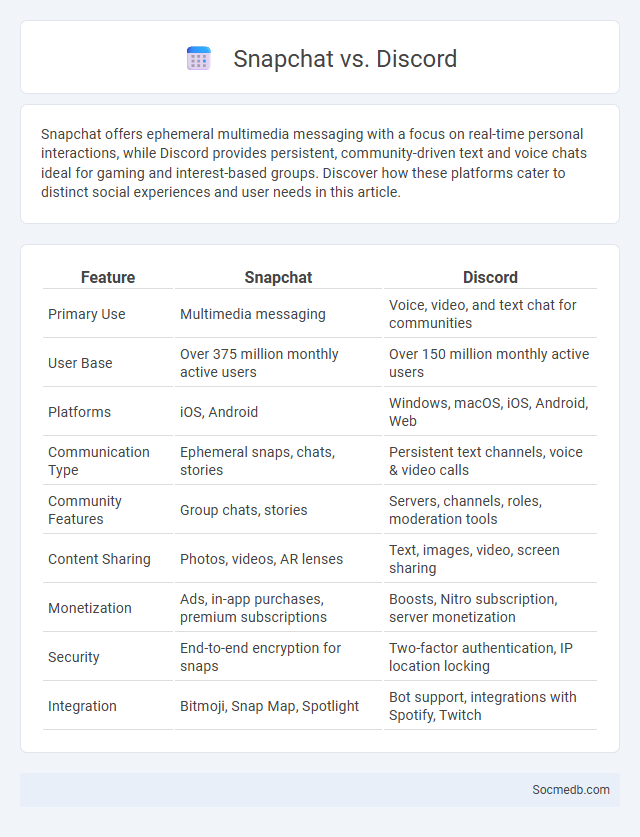
Photo illustration: Snapchat vs Discord
Snapchat offers ephemeral multimedia messaging with a focus on real-time personal interactions, while Discord provides persistent, community-driven text and voice chats ideal for gaming and interest-based groups. Discover how these platforms cater to distinct social experiences and user needs in this article.
Table of Comparison
| Feature | Snapchat | Discord |
|---|---|---|
| Primary Use | Multimedia messaging | Voice, video, and text chat for communities |
| User Base | Over 375 million monthly active users | Over 150 million monthly active users |
| Platforms | iOS, Android | Windows, macOS, iOS, Android, Web |
| Communication Type | Ephemeral snaps, chats, stories | Persistent text channels, voice & video calls |
| Community Features | Group chats, stories | Servers, channels, roles, moderation tools |
| Content Sharing | Photos, videos, AR lenses | Text, images, video, screen sharing |
| Monetization | Ads, in-app purchases, premium subscriptions | Boosts, Nitro subscription, server monetization |
| Security | End-to-end encryption for snaps | Two-factor authentication, IP location locking |
| Integration | Bitmoji, Snap Map, Spotlight | Bot support, integrations with Spotify, Twitch |
Introduction to Social Messaging Platforms
Social messaging platforms like WhatsApp, Facebook Messenger, and WeChat have revolutionized the way individuals communicate, offering instant, real-time text, voice, and video exchanges. These platforms integrate multimedia sharing, group chats, and business communication tools, enhancing personal and professional interactions. Understanding how your audience engages on these channels is crucial for effective messaging and digital marketing strategies.
Overview: Snapchat, Discord, and Chat Defined
Snapchat is a multimedia messaging app known for its ephemeral content and innovative filters, attracting a predominantly younger audience worldwide. Discord serves as a versatile communication platform combining voice, video, and text chat, popular among gaming communities and professional groups alike. Chat applications enable real-time text messaging and often integrate multimedia sharing, fostering instant, interactive communication across diverse social networks.
Key Features Comparison
Social media platforms differ significantly in features such as user engagement tools, content formats, and privacy settings, which influence how you connect and share online. Facebook offers extensive community-building options and event management, while Instagram emphasizes visual storytelling through images and short videos. Twitter prioritizes real-time updates and concise communication, making it ideal for news and trending topics.
User Interface and Experience
A seamless User Interface (UI) and intuitive User Experience (UX) on social media platforms directly influence Your engagement and satisfaction by simplifying navigation and enhancing content discovery. Optimized interfaces prioritize responsive design, ensuring consistent performance across devices, while UX strategies focus on personalized feeds, interactive elements, and quick-loading features to keep users actively connected. Continuous improvements in UI/UX leverage data-driven insights and user feedback to create an immersive and user-centric social media environment.
Privacy and Security Measures
Protecting Your privacy on social media requires robust security measures such as end-to-end encryption, two-factor authentication, and regular privacy setting reviews to prevent unauthorized access. Social media platforms use advanced algorithms and monitoring tools to detect suspicious activities, ensuring your personal data remains secure from cyber threats and data breaches. Staying informed about privacy policies and updating passwords consistently strengthens Your defense against identity theft and online harassment.
Target Audience and Community Building
Social media platforms enable precise targeting of diverse audience segments based on demographics, interests, and online behavior, enhancing content relevance and engagement rates. Building a strong community through consistent interaction, user-generated content, and authentic communication fosters brand loyalty and drives organic growth. Utilizing analytics tools helps identify audience preferences and optimize strategies for sustained community development and higher conversion rates.
Multimedia Sharing Capabilities
Social media platforms offer robust multimedia sharing capabilities, enabling users to upload photos, videos, and live streams with ease. These features support high-resolution formats and interactive elements like filters, stickers, and instant comments to enhance engagement. By leveraging these tools, your content reaches wider audiences and fosters dynamic online interactions.
Integration and Compatibility
Social media platforms prioritize seamless integration and compatibility across devices, ensuring your content is accessible on smartphones, tablets, and desktops without losing quality or functionality. APIs enable smooth connections between social media apps and third-party tools, enhancing automation and user experience. This compatibility boosts engagement and allows your brand to maintain a consistent online presence across multiple channels.
Pros and Cons Analysis
Social media platforms offer significant benefits such as enhanced connectivity, real-time information sharing, and powerful marketing opportunities for businesses. However, they also pose risks including privacy concerns, misinformation proliferation, and potential mental health impacts like anxiety and depression. Balancing these pros and cons is crucial for maximizing social media's positive influence while mitigating its negative effects.
Conclusion: Choosing the Right Platform
Selecting the right social media platform depends on target audience demographics, content type, and marketing goals. Platforms like Instagram excel for visually-driven campaigns, whereas LinkedIn suits professional networking and B2B engagement. Evaluating platform analytics and user behavior ensures optimized reach and higher engagement rates.
 socmedb.com
socmedb.com